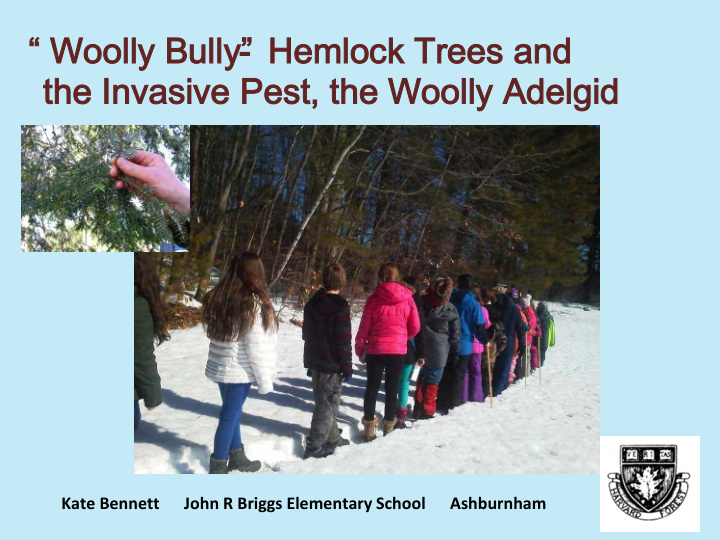



“ Woolly Bully” - Hemlock Trees and the Invasive Pest, the Woolly Adelgid Kate Bennett John R Briggs Elementary School Ashburnham
Tips for Successful Field Experiences • Send a letter home explaining your study and include tentative dates for field work • Prepare your field site- check for any hazards. • Make sure all students visit the restroom before leaving • Practice data taking and other skills inside first • Check all supplies before going out. • All students should be responsible for completing a data sheet. • Remind students that going outside for science is a privilege. Review the basic rules each time. • Have your active students carry the heavy equipment!
Safety First + √ All students should have appropriate footwear and clothing. √ Check with students or the school nurse for possible allergies. √ If it is sunny, hats and sunscreen should be worn. √ Thoroughly check your field site for hazards such as bees’ nests and hanging branches. √ A little rain is ok, but stay out of the woods during storms and on very windy days. √ Take a radio or cell phone with you. √ Review safety rules often.
Get Started in the Classroom- Show Some Pictures- Pictures of students participating in the study are helpful. Show Dave’s PowerPoint . Do some research - there’s a lot on line too.
Practice measuring new growth in the classroom first- this is key!
Preview the data sheet in the classroom. Have the students fill in the top portion. Remind them how important it is to include the date! Where is the crown of the tree? Talk about field notes.
You can access all your past data and other schools’ too.
My method- ● I have six hemlock study trees. 1-6 ● Each tree has ten branches marked A-J ● My students work in teams of four on one tree. ● They divide the branches up. ● Each student must complete a data sheet. ● They sit with their group in the classroom and we enter the data together on the IWB.
Average New Growth hemlock# cm 1 5.3 2 5.9 3 5.5 4 7.7 5 7.4 6 7.7 7 9 8 6.2 9 5.4 10 7.3 average 6.74
Assessment
Integrate lots of science- basic plant physiology, processes and forest ecology in general
Plot Studies With Students Under the Hemlocks Under the Hardwoods
Extending your study across the disciplines
Invasive Species Research
JR Briggs Elementary School
Using Google Earth to Survey the Hemlocks in your Town JR Briggs Elementary School Step 1 Students print out maps (black and white are fine) of their house and yard from the computer. *Make sure they have the latitude and longitude in decimals (under tools).
Using Google Earth to Survey the Hemlocks in your Town JR Briggs Elementary School Step 2 Students take this map home. With a parent they color in any areas that have hemlock trees with a green crayon.
Using Google Earth to Survey the Hemlocks in your Town JR Briggs Elementary School X X Step 3 Students check each hemlock carefully for adelgid. If they see adelgid on a tree, mark that tree with an x on their map. Then take a sample, a small piece of the infested branch and seal it in a ziplock bag. Have the students bring it in to school to do a positive identification under the microscope.
2012 Ash HWA survey Name address latitude longitude Hemlocks HWA + - Josslyn Bourque 40 Winding Cove Rd 42 40 23.20 71 58 18 53 no - Ean Roy 22 Liberty Ln 42 37 45.36 71 54 16.52 yes - Connor Fagan 43 Juniper Rd 42 37 41.73 71 55 32.58 yes - Nicole Snow 56 Lincoln Ave 42 38 57.66 71 57 04.42 no - Michelle Lim 28 Main St. 42 38 10.06 71 54 27.77 no - Kahlan Jones 7 Cross St. 42 36 41.40 71 56 15.63 no - Megan Brown 14 Holden St. 42 38 27.56 71 54 25.40 no - Henry Rittberg 13 South School St. 42 36 33.18 71 55 56.84 yes - Tyler Money 50 Gardner Rd. 42 36 23.33 71 56 53.04 no - David Rousso 228 East Rindge Rd. 42 41 49.85 71 57 14.10 yes - Mackenzie Nims 402 Ashby Rd. 42 40 51.40 71 53 02 49w no - Gabby Thomas 24 Juniper Rd. 42 37 47.65 71 55 40 38 yes - Mike Sullivan 70 Cushing St. 42 38 35.83 71 54 58 33" W no - Rachael Law 58 Corey Hill Rd. 42 37 49.25 71 55 30 61 yes - Chloe Jess 222 Chesnut St. 42 34 27.08 71 59 05 52 yes - Ethan Hindle 46 Central St. 42 37 52.14 71 54 38 96 W no - Liv Kuehl 51 Young Rd. 42 41 08.93 71 57 34 19 W yes - Tyler Antley 53 Winchendon Rd 42 38 11.83 71 55 32. 91 W yes - Jacob Fowler 15 South High St. 42 36 28.14 71 56 35 23 W no - Jake Packard 3 Kelton Rd. 42 38 20.54 71 53 51 25W yes - Finn Picone 49 Willard Rd. 42 37 40.20 71 54 35.38 yes - Olivia scarborough 32 south high st. 42 36 24.29 71 56 43 32 yes - Jenna Oulette 4 Mattakesett Cir 42 39 50.33 71 54 02.28 yes - Ben Gauthier 5 Winding Cove Rd. 42 40 19.98 71 58 10.38 yes - Step 4 Students enter the latitude and longitude of their house from their map on to a spreadsheet. I like to use Google Docs so we can all do it together in the computer lab. Now you have a record of the hemlock trees and adelgid in town. You can add to the spreadsheet every year.
Recommend
More recommend